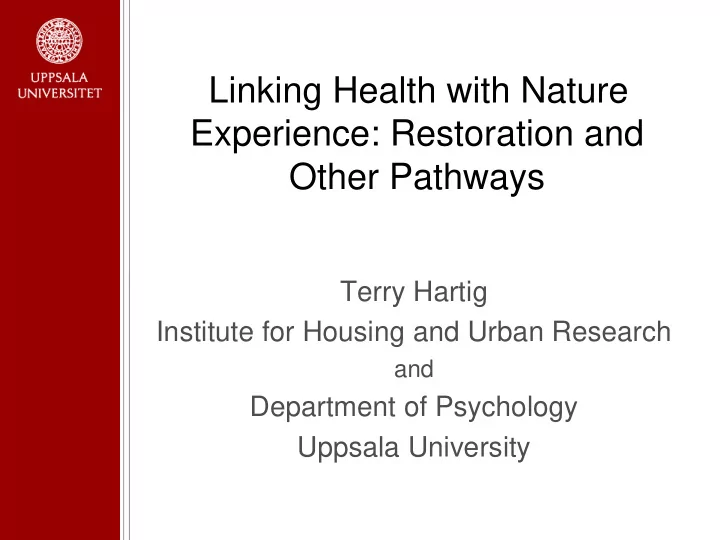

Linking Health with Nature Experience: Restoration and Other Pathways Terry Hartig Institute for Housing and Urban Research and Department of Psychology Uppsala University
Relation between amount of green space (in a 3 km radius) and self-perceived health (percentage stating their health is less than good), with controls for urbanity, sociodemographic and socioeconomic characteristics (from Maas et al., 2006).
Incidence rate ratios for deaths from circulatory disease in income-deprivation quartiles 2 – 4, relative to income deprivation quartile 1 (least deprived), stratified by exposure to green space (from Mitchell & Popham, 2008).
Three intertwined pathways Physical activity Social interaction Restoration
Restoration Discrete restorative experiences
100 90 % Errors Detected 80 70 Natural 60 50 Urban 40 Passive 30 20 10 0 Environment Proofreading performance (% of errors detected) as a function of the environment available for restoration after attentionally demanding tasks (from Hartig et al., 1991).
From Bowler et al. (2010).
Systolic blood pressure change in different environments available after stressor exposure (from Hartig et al., 2003).
Restoration Cumulative effects
Logistic regression analysis of early retirement for health reasons among 19,221 men in Sweden during 1998-99, after 9 years of follow-up (from Hartig & Fransson, 2009). Variables OR (95% CI) Age in 1997 1.179 (1.157 to 1.202) 10-12 years education (ref: 6-9 years) 0.718 (0.513 to 0.865) 13+ years education 0.666 (0.586 to 0.878) Income from work 1997 0.862 (0.849 to 0.875) Family disp. Income 1.018 (1.005 to 1.031) Couple without children (ref: single) 0.752 (0.578 to 0.979) Couple with children 0.506 (0.361 to 0.711) Detached housing (ref: multifamily) 1.212 (0.991 to 1.483) No access to leisure home (ref: access) 1.419 (1.039 to 1.936)
Restoration Social ecological determinants
Estimated parameters for monthly dispensed defined daily doses of selective serotonin re-uptake inhibitors per 1000 persons to men and women in Sweden, 1/1991 – 12/1998 (from Hartig, Catalano, & Ong , 2007). June July August Test month -.0524 (.0465) -.0747* (.0325) .0475 (.0433) temperature (men) Test month -.1317 (.1116) -.2159** (.0717) .1212 (.1174) temperature (women) Note. Standard errors in parentheses. *p < .05, one-tailed. **p < .01, one-tailed.
Relevance to biodiversity protection Restoration as a motive for nature protection
I need time in nature to be happy. Sometimes when I am unhappy I find comfort in nature. Being out in nature is a great stress reducer for me. Norwegian adults (N = 1293) endorsement of three statements about use of nature for psychological restoration (i.e., either agree or do not agree) (from Hartig, Kaiser, & Strumse, 2007).
The association between the use of nature for psychological restoration and general ecological behavior (from Hartig, Kaiser, & Strumse, 2007).
Relevance to biodiversity protection Constrained restoration and the ”pasteurization” of nature
Concluding remarks Progress is being made in building the body of evidence on the processes through with nature experience becomes linked with health. Psychological restoration is a key process. Restorative experiences in nature can help to support efforts to preserve biodiversity. Yet, the desire for restoration in nature may also hinder efforts to preserve biodiversity.
References Bowler DE, Buyung-Ali LM, Knight TM, Pullin AS (2010). A systematic review of evidence for the added benefits to health of exposure to natural environments. BMC Public Health 10, 456. Hartig T, Catalano R, Ong M (2007). Cold summer weather, constrained restoration, and the use of anti-depressants in Sweden. Journal of Environmental Psychology 27, 107-116. Hartig T, Evans GW, Jamner LD, Davis DS, Gärling T (2003). Tracking restoration in natural and urban field settings. Journal of Environmental Psychology 23, 109-123. Hartig T, Fransson U (2009). Leisure home ownership, access to nature, and health: A longitudinal study of urban residents in Sweden. Environment and Planning A 41: 82-96 . Hartig T, Kaiser FG, Strumse E (2007). Psychological restoration in nature as a source of motivation for ecological behavior. Environmental Conservation 34, 291-299. Hartig T, Mang M, Evans GW (1991). Restorative effects of natural environment experiences. Environment and Behavior 23, 3-26. Maas J, Verheij RA, Groenewegen PP, de Vries S, Spreeuwenberg P (2006). Green space, urbanity, and health: How strong is the relation? Journal of Epidemiology and Community Health 60, 587-592. Mitchell R, Popham F (2008). Effect of exposure to natural environment on health inequalities: an observational population study. Lancet 372, 1655-1660 Photo credit: Aedes stictitus, floodwater mosquito; Johan Nilsson. Other photos by Terry Hartig.
Recommend
More recommend